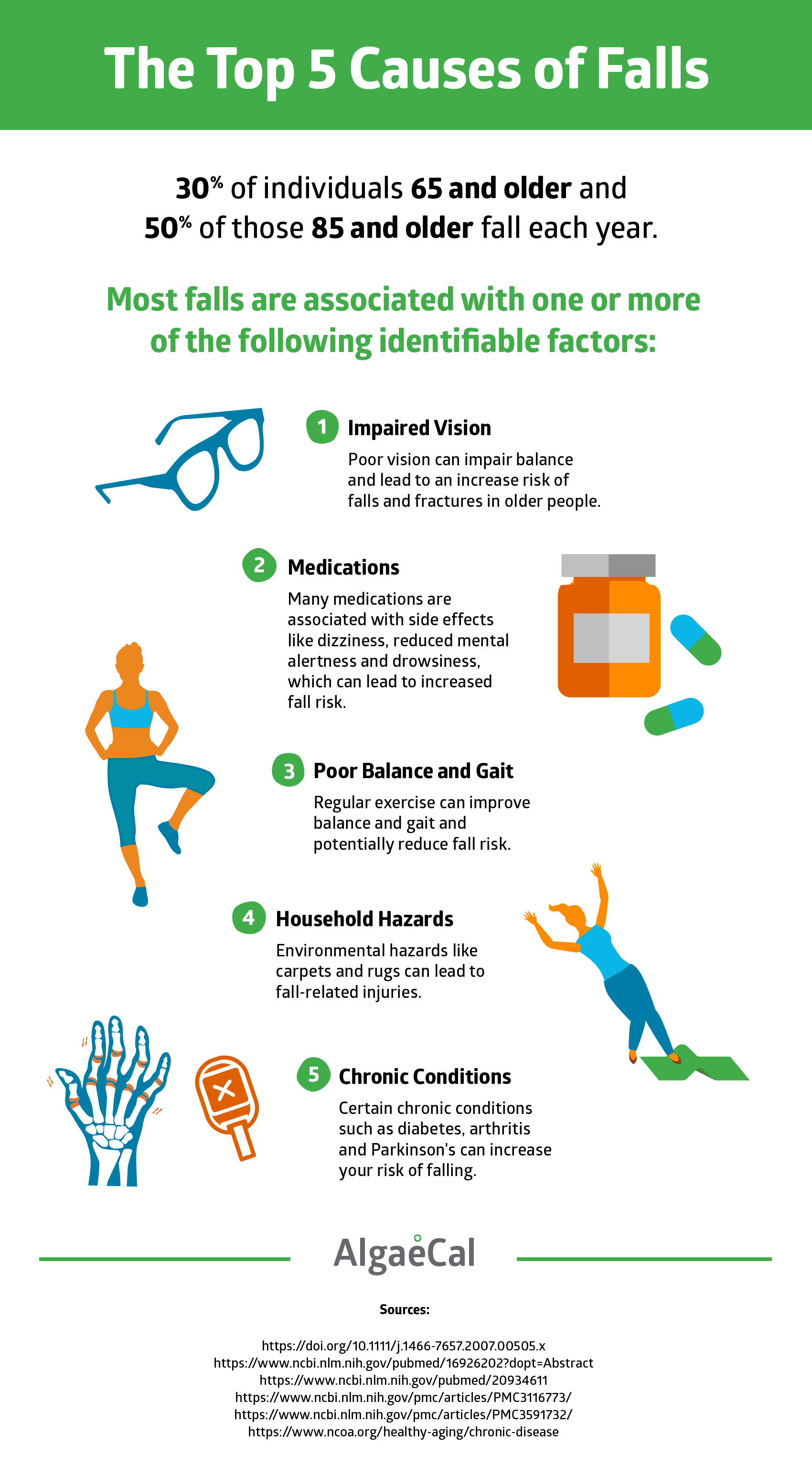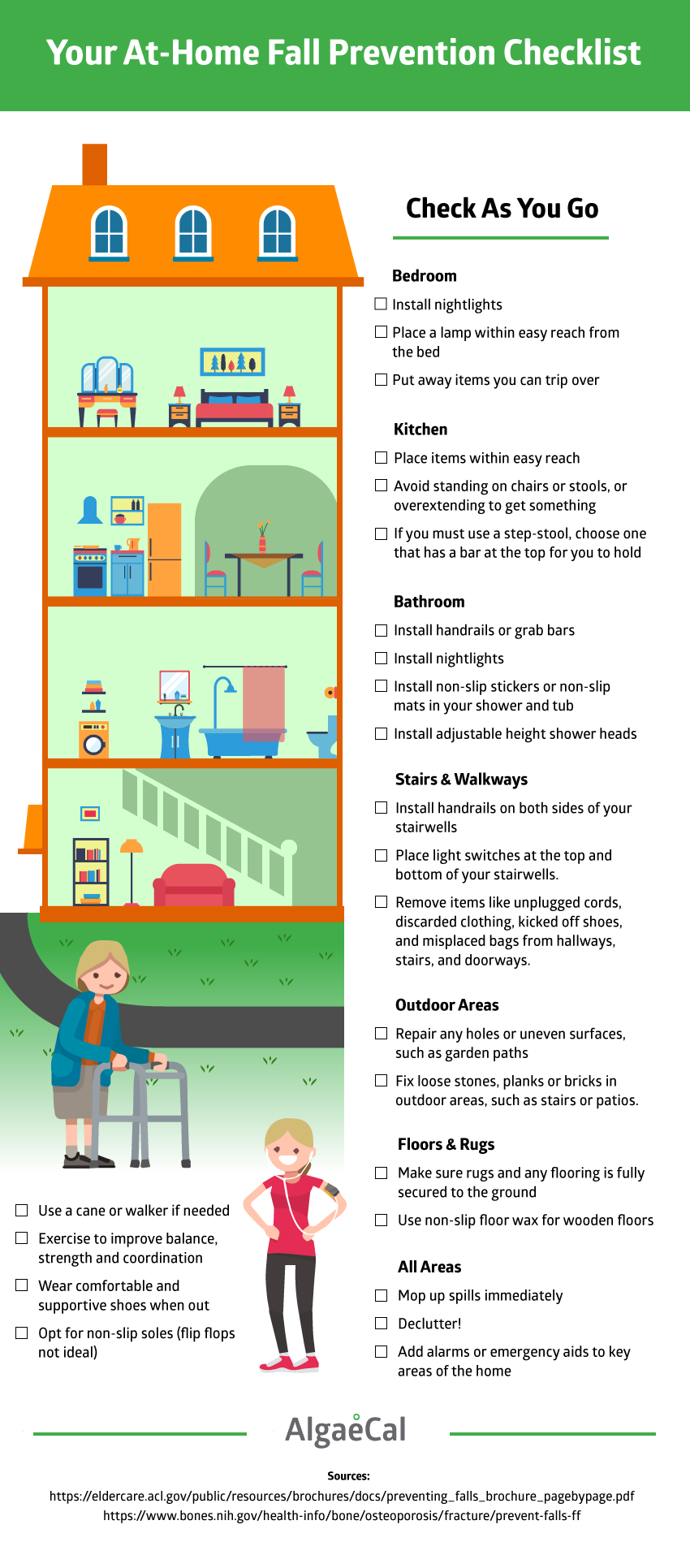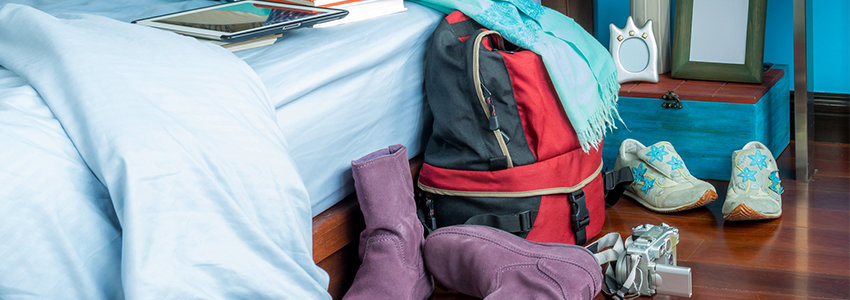When it comes to seniors and fall-related injuries, the numbers are sobering…
Falls are the number one cause of death in older adults. Within the first year of a fall resulting in a hip fracture, one in five people die and less than one-third return to their pre-fall level of health.
More than 90% of hip fractures are tied to a fall-related injury, with the majority of those fractures occurring in people over the age of 70.
The best way to avoid taking a tumble is to be proactive. Moving with caution, securing tripping hazards, and maintaining strong muscles through exercise are just a few of the ways you can help yourself stay on your feet.
Keep reading to learn about what causes falls and how to best protect yourself.
The Top 5 Causes of Falls
Before you can begin fall-proofing your life, it’s best to start with the “how”. The leading causes behind falls can be lumped into three categories: physical, medical, and environmental.
Paying attention to risk factors like physical weakness, medications that make you dizzy or sleepy, or even clutter around your house can make a big difference. Research shows being aware of existing risk factors can significantly reduce the chances of falling.
Impaired Vision
It’s hard to be aware of the obstacles around you if you can’t see them! Glaucoma and cataracts can both impair depth perception, peripheral vision, and acuity. Bifocals can also cause problems on stairs even when the prescription is correct, so be extra careful with those! Stay ahead of the game by getting an annual eye exam to check for eye diseases and to keep your prescription up-to-date.
Medications
While you might not be worried about operating heavy machinery at this stage of the game, certain medication can have side effects that even make walking difficult. Common side effects include drowsiness, dizziness, and confusion. Pay close attention to blood pressure medication, sleeping pills, heart medicine, diuretics, and muscle relaxants in particular.
[embed_infographic title=”Top 5 Causes of Falls” alt=”Top 5 Causes of Falls infographic” src=”algaecal.com/wp-content/uploads/falling-infographic-1.png”]
Balance and Gait
Weakness and poor balance can lead to falls. As we age, losing balance, flexibility, and coordination is common. While ignoring the problem can be dangerous, being overly cautious to the point of inactivity can also be problematic. That’s why it’s important to keep building muscle strength and mobility.
Household Hazards
Poor lighting, clutter, and a lack of handrails can all increase your chances of tripping or taking a tumble. Keep pathways clear of obstacles, use handrails on stairs and in the bathroom, and ensure adequate lighting throughout your home to ensure you can see and avoid fall hazards.
Chronic Conditions
More than 80% of older adults have at least one chronic condition and 68% have at least two. Certain conditions like heart disease, diabetes, arthritis, and Parkinson’s can increase your risk of falling. The pain, mobility issues, and medications associated with those diseases can all play a part.
Steps For Fall Prevention
When mobility and balance begin to deteriorate with age, it becomes increasingly important to be aware of your surroundings and your own physical abilities. Knowing the side effects of any medications you take empowers you to make safe choices, and simple strengthening exercises can help you to regain your balance after a stumble and potentially avoid falls altogether.
Multiple clinical trials and extensive research show that the most effective means of reducing fall rates are risk assessment programs, exercise regimes, and environmental inspections. This means being aware of your individual fall risks, strengthening muscles and improving balance or gait issues, and making conscious assessments of environmental hazards like clutter or loose flooring.
Talk to Your Healthcare Provider
A great first step in your fall prevention journey is to speak with your doctor. A healthcare practitioner will be able to fill you in on potential side effects or complications through a medication review. Know how, when, and why you’re taking any prescribed medications so you can feel confident and knowledgeable about what you’re putting into your body and how it affects you.
Exercise Regularly
Changes to gait and balance can often be so gradual that it’s hard to judge how far things have progressed. To get an idea of where you stand, get a friend, family member, or your doctor to help you complete the Get Up and Go and Tinetti Balance and Gait tests.
Your results will help to establish a baseline for your current abilities and can be useful in setting goals moving forward.
Once you know where you’re at, look to fall prevention-specific exercises with a focus on balance. To help get you started, we have compiled three easy and super effective balance exercises for anyone looking to stay steady on their feet.
Already mastered the toe-heel raise, chair pose, and single-leg stand? Try incorporating yoga, tai chi, or step classes into your routine. If you feel more comfortable practicing at home, check out our Ultimate Guide to Yoga for Osteoporosis and learn how you can help build better bones in just 12 minutes a day.
Maintain or Improve Bone Health
If you’re looking to support your bone health from all fronts, look no further than the linebackers of the bone builder lineup — AlgaeCal Plus and Strontium Boost.
This dynamic duo is clinically supported to improve bone health and actually increase bone density in as little as six months. The unique algae-derived formula is packed with highly absorbable calcium, magnesium, and trace minerals, and everything else you need to have strong, healthy bones well into your golden years. And for every bit of bone density AlgaeCal Plus helps you build, Strontium Boost is there to supercharge its effects nearly threefold. Strontium Boost also inhibits bone loss and increases bone mass — an exciting double benefit!
But don’t just take our word for it. Countless customers have seen the impact of our Bone Builder Pack firsthand.
Take Debbie for instance, who fractured her wrist all too easily and discovered she had low bone density after going for a DEXA scan. Debbie found AlgaeCal and has seen steady improvement to her bone density in each subsequent DEXA scan.
Fallproof Your Home
The final step to fall-proofing your life is creating a safe space to live in. Navigating your way through your home shouldn’t feel like an obstacle course, so to help you out, we’re proud to present to you… *drumroll, please*
The Ultimate Fall Prevention Checklist!
Bedroom
- Install nightlights or place a lamp within easy reach from the bed in case you need to get up in the middle of the night
- Avoid leaving tripping hazards — like shoes, purses, and papers — on the floor, particularly in areas where you commonly walk
- Remove large cumbersome rugs that are easy to trip over or use double-sided tape to secure the edges to the floor
- Keep a flashlight handy in the nightstand next to your bed in case of power outages
Kitchen
- Place items within easy reach, particularly heavy and frequently used items
- Avoid standing on chairs or stools, or overextending to get something
- If you must use a step-stool, choose one that has a bar at the top for you to hold on to
Bathroom
- Install handrails or grab bars in the bathroom to help get in and out of the shower and tub
- Install nightlights for middle-of-the-night visits to the bathroom
- Install handrails near the toilet to sit down and stand with ease
- Install non-slip stickers or non-slip mats in your shower and tub
- Remove soap build-up from all areas of your bathroom as this can be slippery
- Install adjustable height shower heads. Not only can you remove the shower head and adjust its height, you can also utilize it as a vertical railing to hold on to
- Place double-sided tape on the bottom of bathroom mats to avoid slips and loose edges
Want the PDF printable below? Click here to download.

[embed_infographic title=”Fall Prevention Checklist” alt=”Fall Prevention Checklist infographic” src=”algaecal.com/wp-content/uploads/falling-infographic-2.png”]
Stairs & Walkways
- Install handrails on both sides of your stairwells
- Place light switches at the top and bottom of your stairwells. Proper lighting can decrease your fall risk (more on that below)
- Remove items like unplugged cords, discarded clothing, kicked off shoes, and misplaced bags from hallways, stairs, and doorways. Keeping your pathways clear at all times will go a long way in preventing falls at home
- Put nightlights in hallways, bathrooms, bedrooms and the kitchen for visibility at night
Outdoor Areas
- During the winter, ask someone to clear your walkways and driveway of snow and spread salt or sand on icy surfaces if you’re unable to do it yourself
- In the autumn, ask someone to rake and clean any leaves or branches that may obstruct your walkways
- Repair any holes or uneven surfaces in walkways and garden paths
- Fix loose stones, planks, or bricks in outdoor areas, such as stairs or patios
- Ensure there are no tripping hazards en route from the kitchen to the outdoor entertaining area: when you are carrying dishes or other items outside, you will likely have your field of vision partially blocked by what you are carrying
Floors & Rugs
- Make sure rugs and any flooring is fully secured to the ground
- Use non-slip rugs or double-sided tape to set flooring in place. These can be found at any local department or hardware store
- If you have hardwood floors, do not wear socks or worn out slippers as you can easily slip and lose your balance. If you prefer to walk around with slippers, ensure that the grip is not worn out
- Use non-slip floor wax for wooden floors
All Areas
- Mop up spills immediately
- If floors are wet after cleaning — do not walk on them. Place a warning sign for others in your home so they also know that the floor is wet
- Arrange your furniture and home decor to give you enough room to walk freely
- Make sure all your handrails are in good condition (not broken) and securely attached
- Declutter! Keeping your home tidy with everything put away is a great habit. Clutter is not your friend when you’re trying to reduce the risk of falls
- Use a cane or walker if needed
- Add professionally installed ramps to areas of the home if they are needed to allow for better mobility
- Add alarms or emergency aids to key areas of the home, such as the bathroom and kitchen, in the event that you do take a tumble. You will need to get help quickly and easily, and may not always be within reach of a phone
- If you require corrective lenses, make sure you use them at night and during the day to reduce your fall risk
Wear Proper Footwear
- Wear comfortable and supportive shoes when out
- Opt for non-slip soles (flip flops not ideal)
If You Fall Down, What Should You Do?
Falling is a common occurrence among seniors and while it can be a painful and stressful experience, it should comfort you to know that there are many options available to help your recovery.
For starters, you should immediately call your doctor and book an appointment. Not only will the doctor aid you in your recovery, but they can come up with solutions and strategies to help you avoid finding yourself in a similar situation in the future. It’s important to be open with your doctor about any pains or medical issues you have, as you may not realize that you’re dealing with an issue that directly contributed to you falling. If possible, try and provide as much detail as possible about the incident as this will allow for a much clearer assessment of the situation.
It’s also a good idea to see a specialist — optometrist, physiotherapist, orthopedic doctor, etc. — who can provide additional support and treatment. If you’re having problems seeing, that can impact your balance and put you at a higher risk of tripping. An optometrist can provide the specialized support that a general practice doctor may not be able to offer. Often times, your doctor is the one who will refer you to a specialist.
As you age, falling down poses a serious risk to health and general wellbeing. Having as much information as possible about preventing falls, taking the right precautions, and getting the right help is critical to living a safe and healthy life.
If you do happen to fall and fracture a bone, we have you covered. Check out our 5 Step Post-Fracture Healing Plan to speed up your fracture recovery.
 Takeaways
Takeaways
As you can see, taking a few simple precautions won’t break the bank, but they can help stop you from breaking a bone. Creating a safer home environment will not only help prevent falls, but provide you with a sense of comfort and peace of mind. And you can’t put a price tag on that.
When you’re not home, you can still take many precautions that can go a long way to keeping you upright.
- Do your best to live a healthy and active lifestyle. With regular exercise and proper eating, you can strengthen your muscles and improve your balance.
- Wear proper footwear. The right shoes fit snugly and have proper grip on the bottom.
- Take a sight test. Just like with your balance, sometimes eyesight changes are gradual and you won’t realize how fuzzy your vision was until you’re back at 20/20.
- If you’re on medication, be sure to strictly follow the dosage instructions. Also, be sure to talk to your doctor about the medication you’re taking and see if they’re still right for you.
If you have any questions or additional tips on fall prevention, please share them in the comments section below.
Until next time – take care, live life, and stay on your feet!





John Daniel
September 15, 2017 , 5:12 amVery Useful Blog! Fall prevention for seniors is a very important issue. Receiving serious injury from falls is the number one accident that happens to the elderly. The final piece to fall prevention for seniors is to make sure the home is free of clutter and properly lit. It is important to keep the floor free from any obstacles that could lead to tripping. Loose rugs, dog bones, articles of clothing or shoes, even electrical cords can all present dangerous hazardous and should not be in walk areas. One can also install grab bars. There are also many exercise equipment available for seniors. These are easily available in market and one can also view Online.